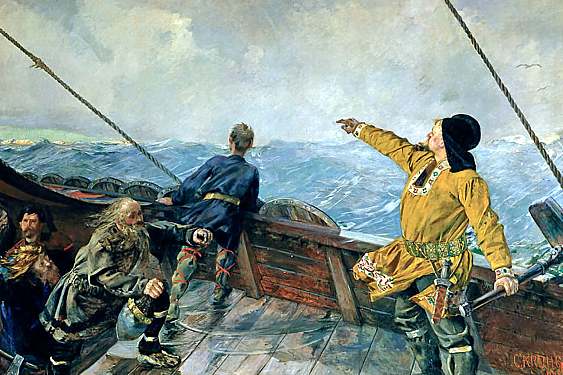
|

|
Leifur heppni Eiríksson
born: around 980 at Eiríksstađir in Haukadalur in Iceland
died: around 1020 in Greenland
Leifur is perhaps best known for exploring Vínland, in North America. He built houses there, paving the way for other explorers and settlers who followed later. His father, Eiríkur, was a man who was quick to use his weapons, which caused him to be driven first out of Norway, and then out of Iceland. Eiríkur led a party to explore, and then to settle Greenland. When a report came in of lands that had been spotted further to the west, Leifur outfitted a ship and prepared to seek and explore those new lands.
He asked his father, Eiríkur, to lead the expedition, saying the elder man had more luck than anyone else in the family. In the Viking age, luck was thought to be an innate quality in an individual. People attempted to bring lucky people into their enterprises, so that their luck would help the project. Eiríkur reluctantly agreed to join the expedition, but as he rode to the ship to depart, his horse stumbled, and he fell, a very bad omen in the Viking age. He concluded that fate did not intend for him to discover any more lands than he already had. He stayed home. The saga tells of the voyage.
 |
Once he made ready, Leif set sail. After being tossed around at sea for a long time he chanced upon land where he had not expected any to be found. Fields of self-sown wheat and vines were growing there; also, there were trees known as maple, and they took specimens of all of them. Leif also chanced upon men clinging to a ship's wreck, whom he brought home and found shelter for over the winter. In so doing he showed his strong character and kindness. Afterwards he became known as Leif the Lucky. Eiríks saga rauđa, ch. 5 |
Two separate sagas tell of Leifur's voyage: Eiríks saga and Grćnlendinga saga. While there are many similarities between the two descriptions, there are also many significant differences. It is thought that the booths and houses built by Leifur and used by subsequent explorers were the Viking-age structures excavated at L'Anse aux Meadows in Newfoundland, Canada. Evidence in the sagas, and archaeological evidence found at L'Anse aux Meadows suggests that the site was a temporary way station, rather than a permanent settlement, and that the Norse explorers traveled much further to the south.
The site of the Vínland settlement described in the saga may never be found, since the most likely sites are in the heavily developed parts of New England or Canada, where the archaeological records have almost certainly been disturbed or obliterated.
Leifur's lucky find and rescue of the shipwrecked sailors was not simple luck. His keen eye, his curiosity, and his exceptional sailing skills made the rescue possible, as is told in more detail in Grćnlendinga saga.
|
|
©2013-2025 William R. Short |